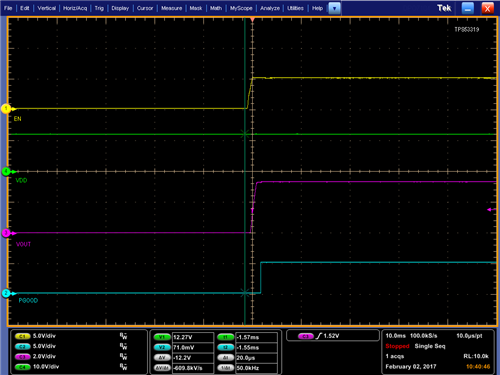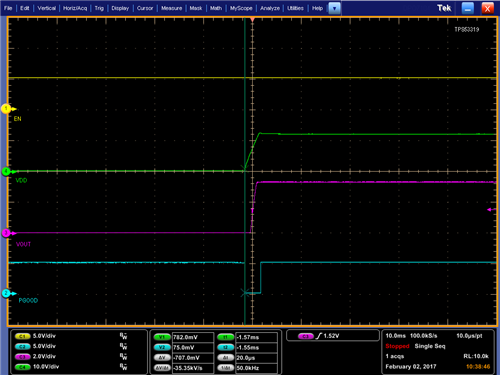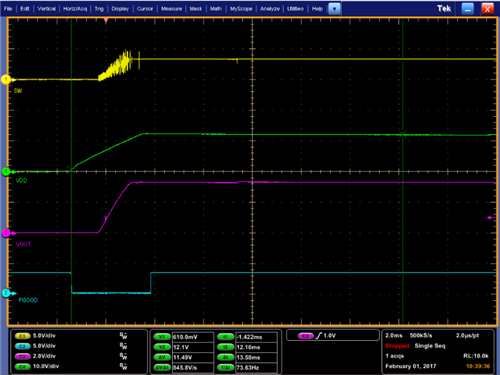Good Pin Practices with Buck Converters
Many synchronous buck converter designers face a common issue: how best to connect the open drain power-good flag, also known as the power-good (PGOOD) pin. In this post, I will explore the expected behavior of power good when it is tied to various different pull-up sources. There has been some misinformation floating around that hopefully this post will clarify.
As many converter data sheets describe, the function of the PGOOD pin is to indicate high after the switcher output gets within the target regulation. For instance, when the output voltage of one of TI’s step-down regulators with integrated switchers is within +10% and -5% of the target value, internal comparators detect a power-good state and the open-drain field-effect transistor (FET) turns off, enabling the power-good signal to rise to the pull-up voltage. If the output voltage goes outside of +15% or -10% of the target value, the open-drain FET turns on and the power-good signal becomes low after a short 2ms delay. Power good will also go low (regardless of output voltage) in a few other scenarios, such as when enable goes low, in order to facilitate quick shutdown sequencing in daisy-chained systems.
The recommended pull-up for the PGOOD pin is to tie it to the internally generated VREG pin or BP pin. The output remains low when the device is disabled or not powered, which has the benefit of defining the power-good state before any bias is present. Some users with different input/output (I/O) voltages prefer to pull the PGOOD pin up to an external bias like 3.3V, which can introduce some complications due to timing. Before providing VIN/VDD (typically 12V), there is nothing powering the comparators and logic “defining” the power-good state. At this time (before applying power), the open-drain FET’s gate voltage is determined by leakages and is more likely to turn off than to turn on. Coupling that fact with an external pull-up voltage that could be present before VIN/VDD can lead to the PGOOD pin showing high during an otherwise PBAD state.
Figure 1 through Figure 5 are scope shots of PGOOD pulled up by VREG, and PGOOD pulled up by an external voltage using the TPS53315 and TPS53319 synchronous buck converters. Note how PGOOD will float up to the pull-up voltage, even though the device is not regulating.
 Figure 1 The TPS53315 Power Good Is
Clean with No Glitches
Figure 1 The TPS53315 Power Good Is
Clean with No Glitches Figure 2 The TPS53319 Power Good Is
Clean with No Glitches
Figure 2 The TPS53319 Power Good Is
Clean with No Glitches Figure 3 The TPS53315 Power-good Glitch
That Results in PGOOD Ties to Enable: Enable Power Goes High First, Then
VDD
Figure 3 The TPS53315 Power-good Glitch
That Results in PGOOD Ties to Enable: Enable Power Goes High First, Then
VDD Figure 4 The TPS53319 Power-good Glitch
That Results in PGOOD Ties to Enable: Enable Power Goes High First, Then
VDD
Figure 4 The TPS53319 Power-good Glitch
That Results in PGOOD Ties to Enable: Enable Power Goes High First, Then
VDD Figure 5 The TPS53319 Power-good Glitch
That Results in an External 3.3V Pull-up on PGOOD Being Present before
VDD/VIN
Figure 5 The TPS53319 Power-good Glitch
That Results in an External 3.3V Pull-up on PGOOD Being Present before
VDD/VINIt is best to use a self-derived voltage through dividers in order to guarantee the logic state of the PGOOD pin at all times. When using external always-on voltages, the downstream logic needs extra consideration in order to avoid a small power good glitch before the controller power supply (VDD) gets up to ~1V. Get more information on all of TI’s buck converters with power good.
IMPORTANT NOTICE AND DISCLAIMER
TI PROVIDES TECHNICAL AND RELIABILITY DATA (INCLUDING DATASHEETS), DESIGN RESOURCES (INCLUDING REFERENCE DESIGNS), APPLICATION OR OTHER DESIGN ADVICE, WEB TOOLS, SAFETY INFORMATION, AND OTHER RESOURCES “AS IS” AND WITH ALL FAULTS, AND DISCLAIMS ALL WARRANTIES, EXPRESS AND IMPLIED, INCLUDING WITHOUT LIMITATION ANY IMPLIED WARRANTIES OF MERCHANTABILITY, FITNESS FOR A PARTICULAR PURPOSE OR NON-INFRINGEMENT OF THIRD PARTY INTELLECTUAL PROPERTY RIGHTS.
These resources are intended for skilled developers designing with TI products. You are solely responsible for (1) selecting the appropriate TI products for your application, (2) designing, validating and testing your application, and (3) ensuring your application meets applicable standards, and any other safety, security, or other requirements. These resources are subject to change without notice. TI grants you permission to use these resources only for development of an application that uses the TI products described in the resource. Other reproduction and display of these resources is prohibited. No license is granted to any other TI intellectual property right or to any third party intellectual property right. TI disclaims responsibility for, and you will fully indemnify TI and its representatives against, any claims, damages, costs, losses, and liabilities arising out of your use of these resources.
TI’s products are provided subject to TI’s Terms of Sale (www.ti.com/legal/termsofsale.html) or other applicable terms available either on ti.com or provided in conjunction with such TI products. TI’s provision of these resources does not expand or otherwise alter TI’s applicable warranties or warranty disclaimers for TI products.
Mailing Address: Texas Instruments, Post Office Box 655303, Dallas, Texas 75265
Copyright © 2023, Texas Instruments Incorporated